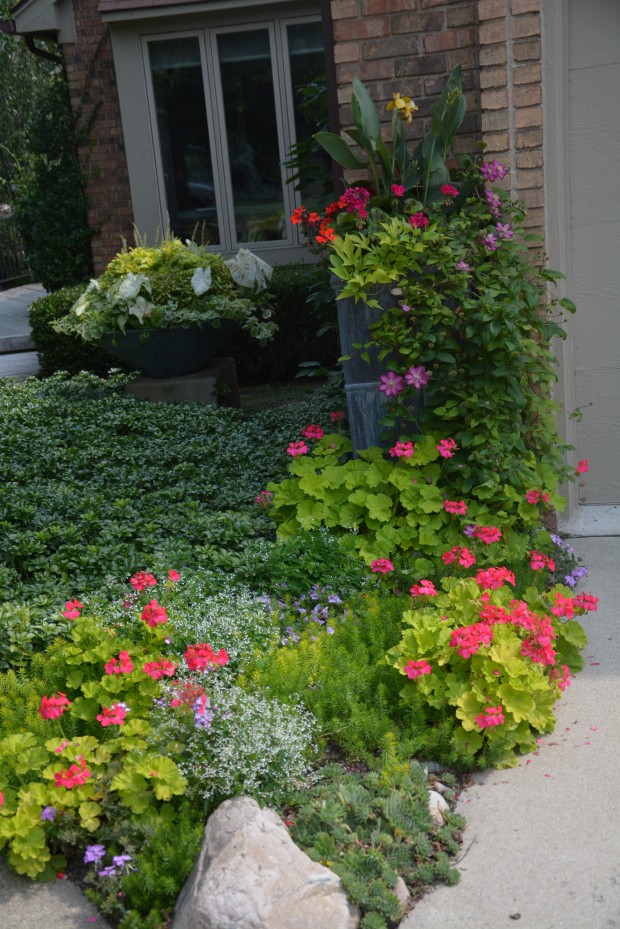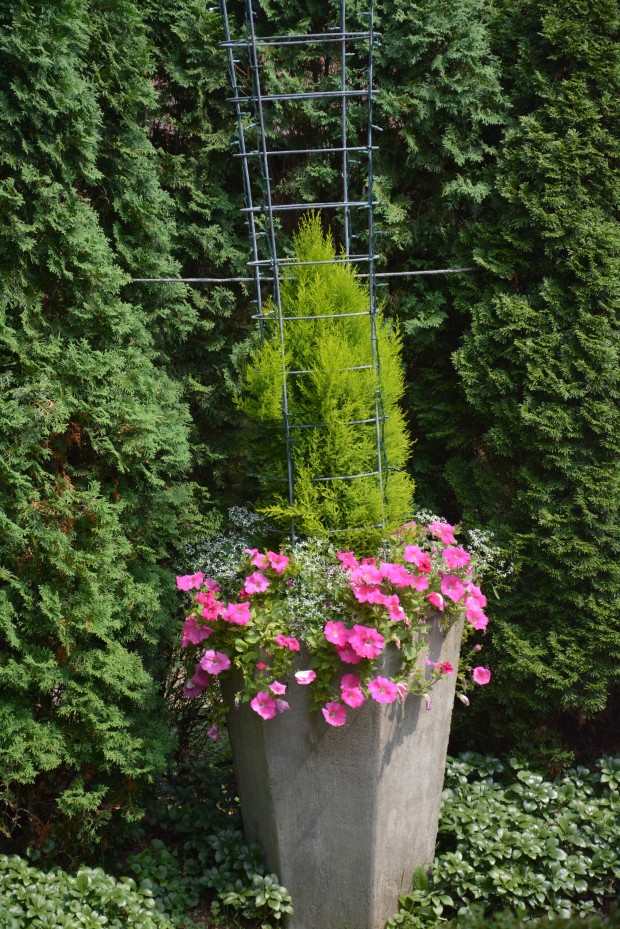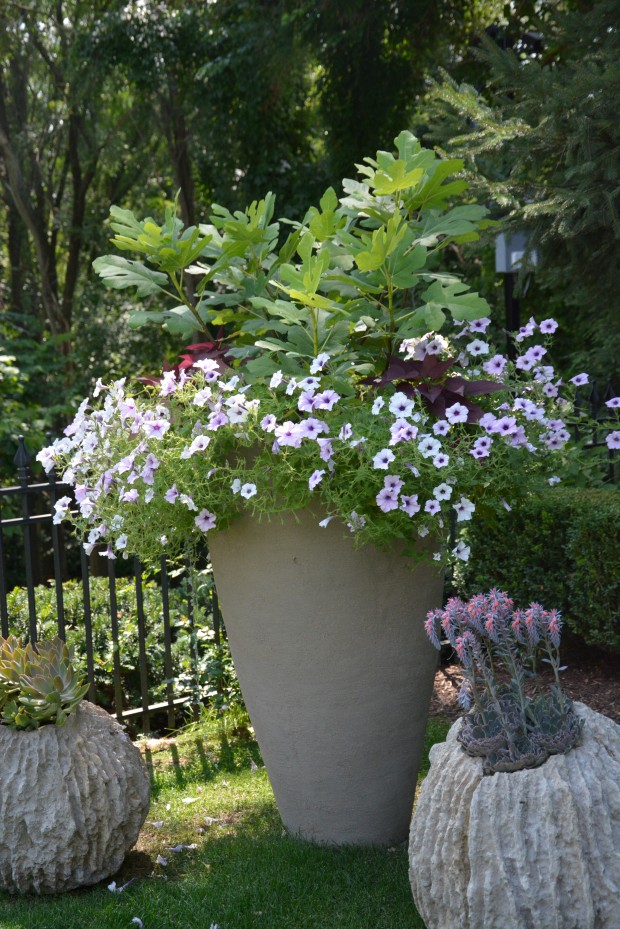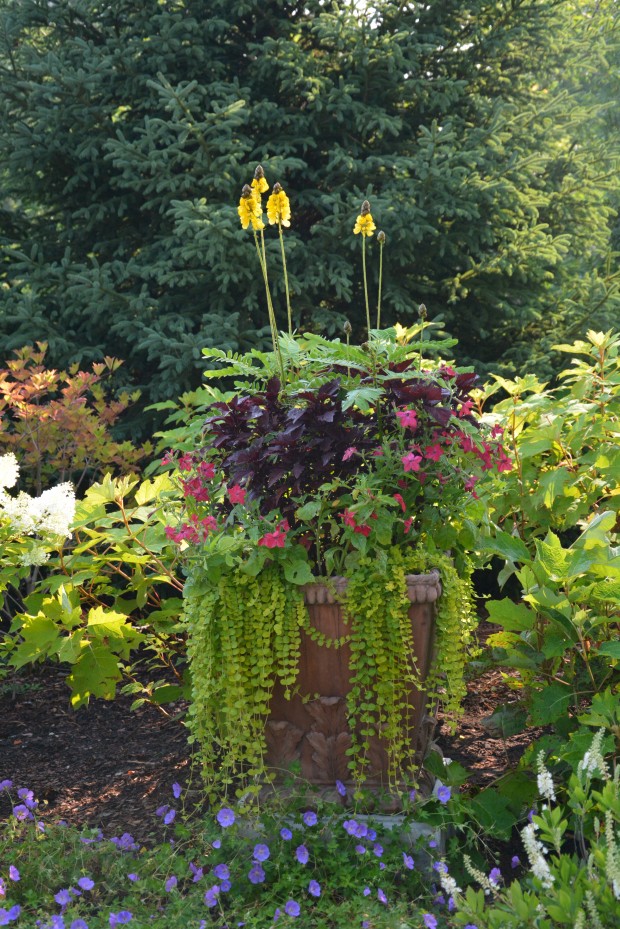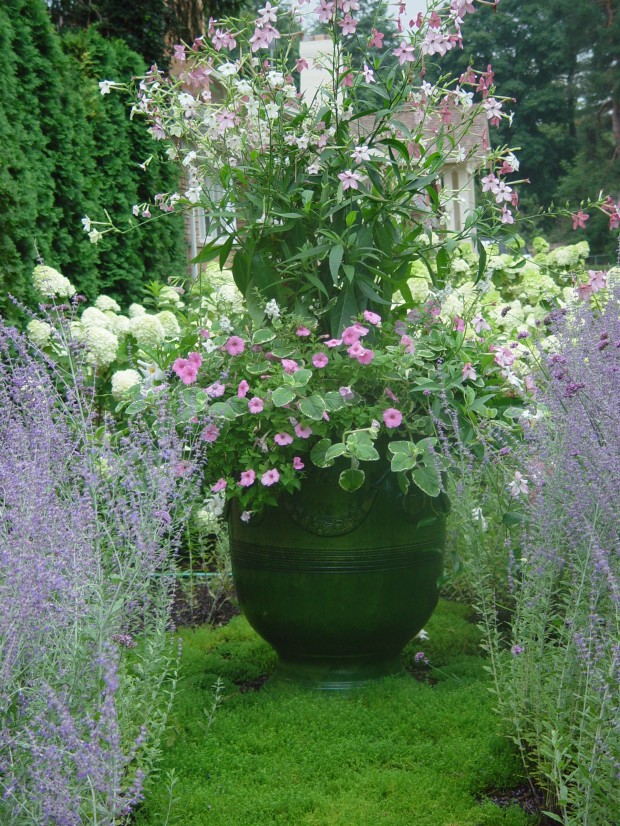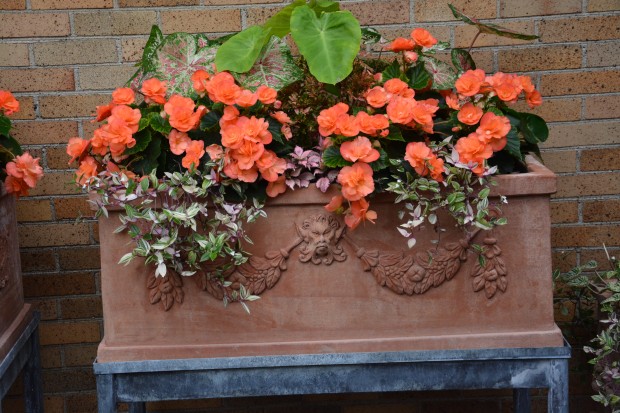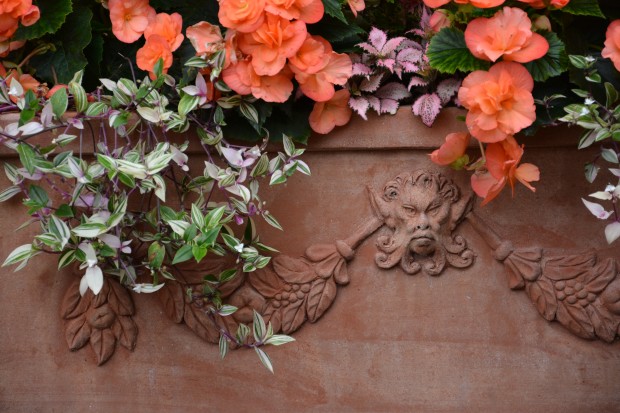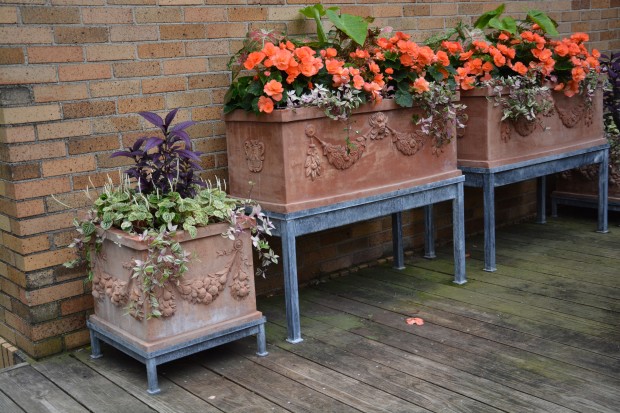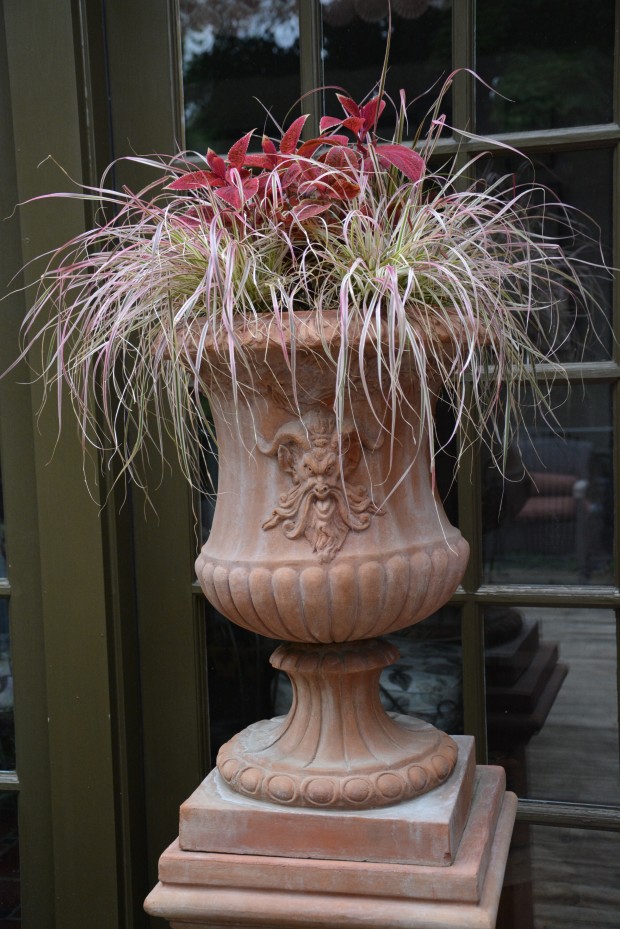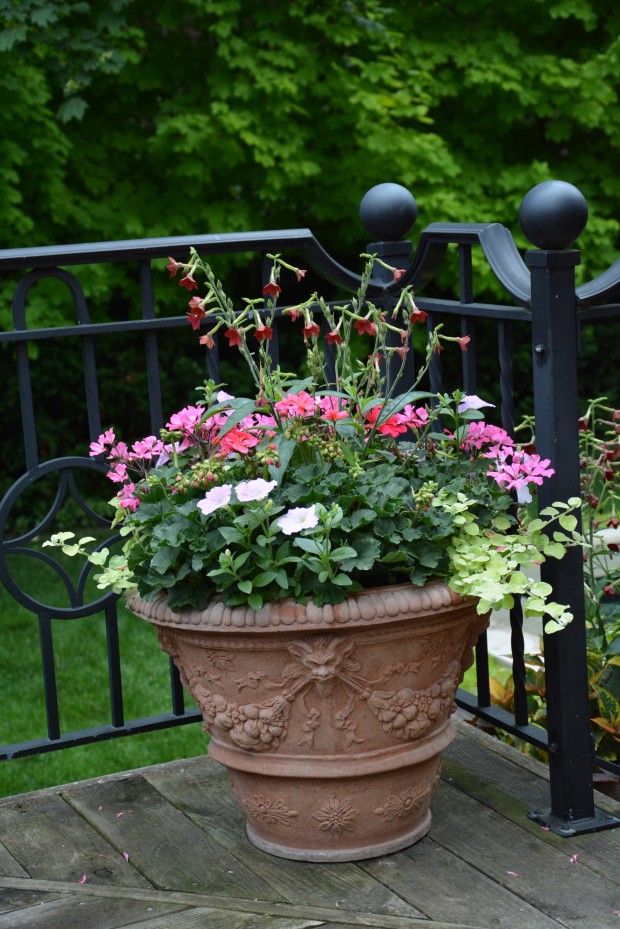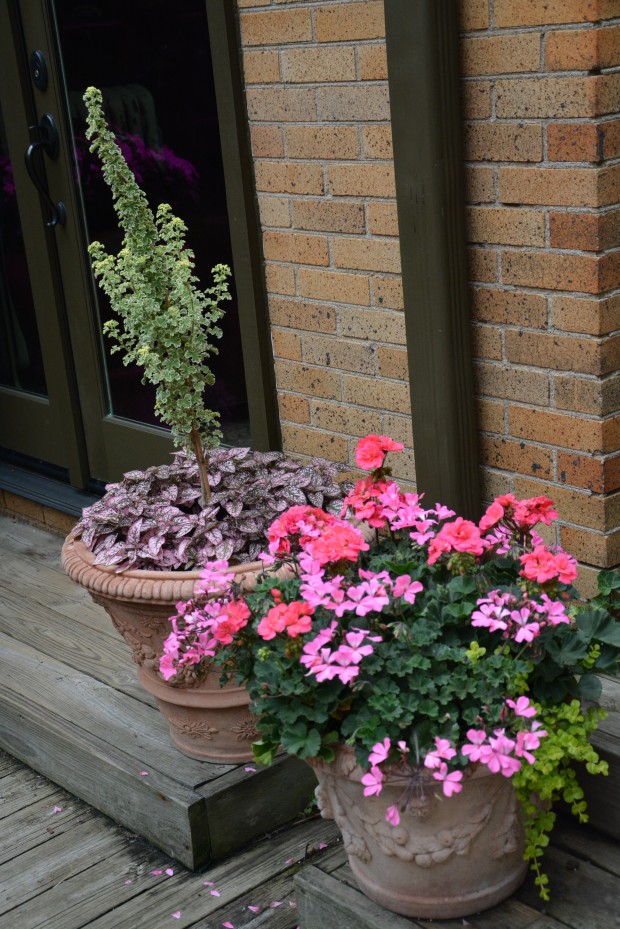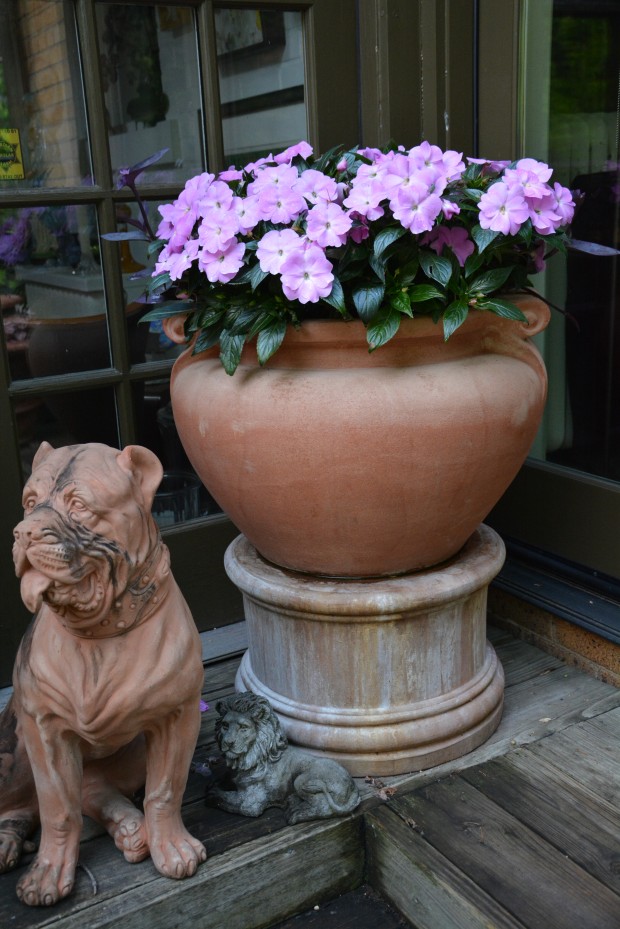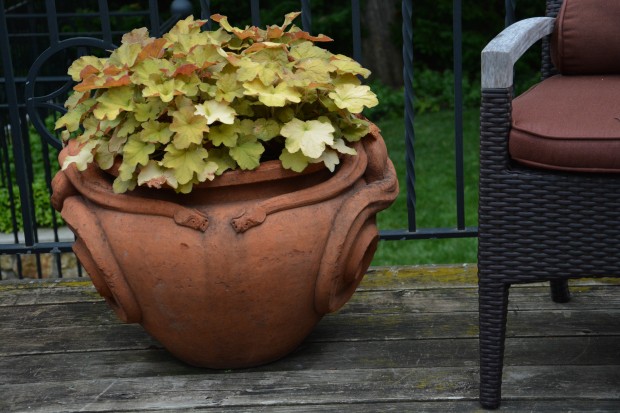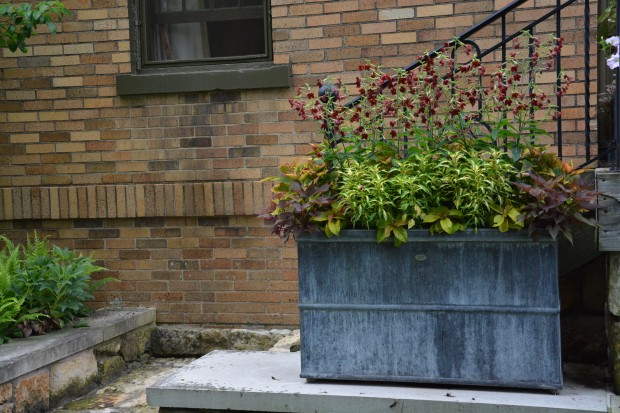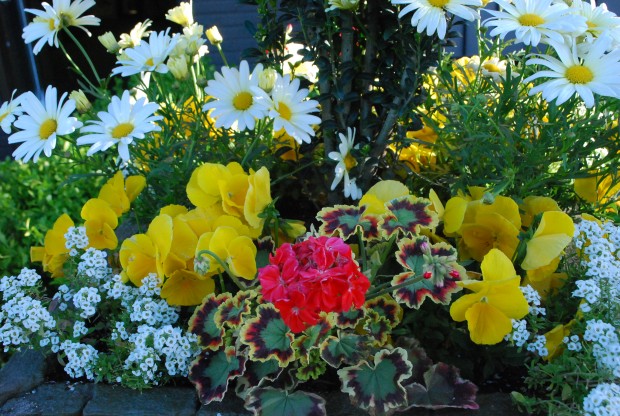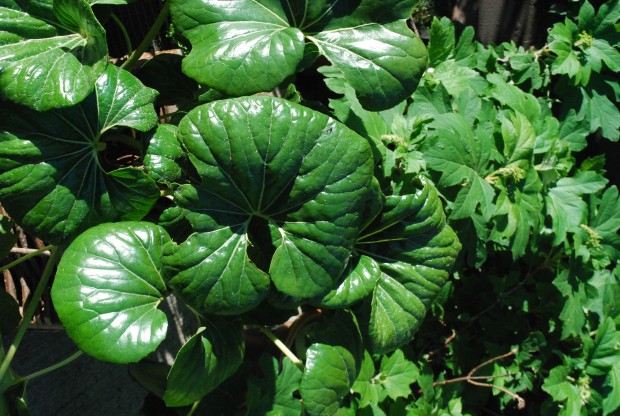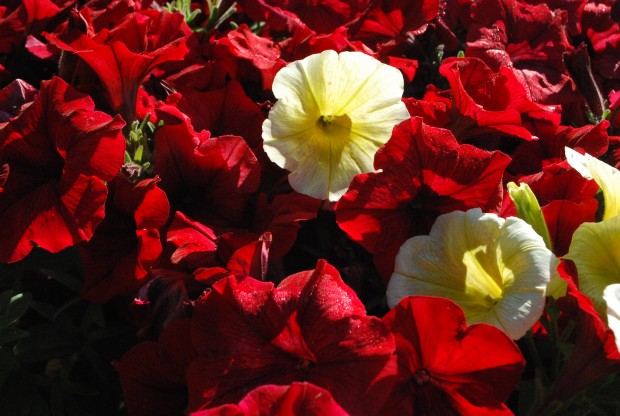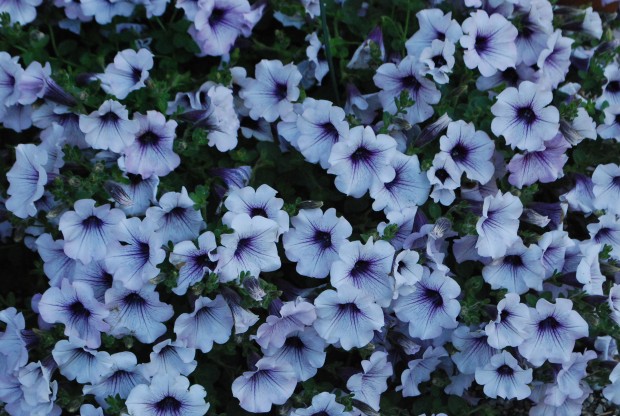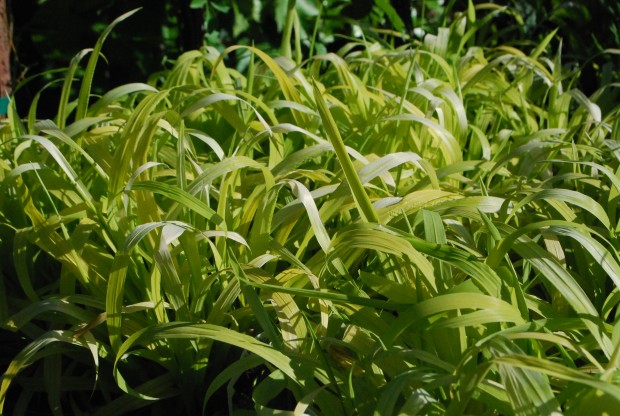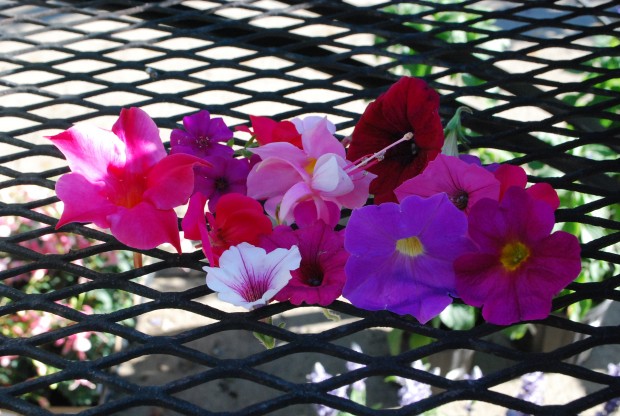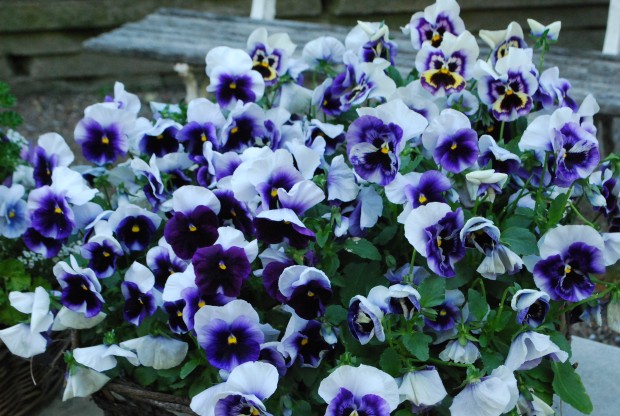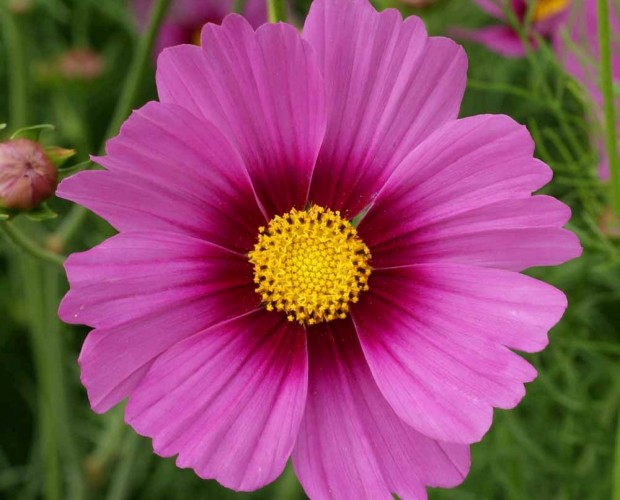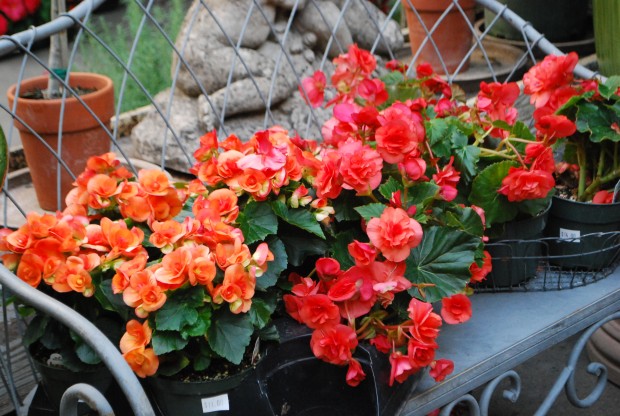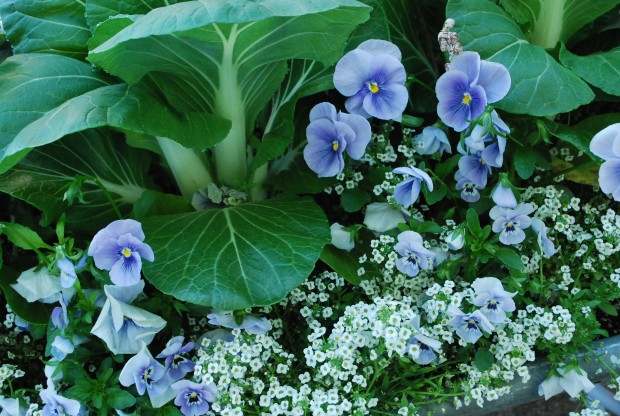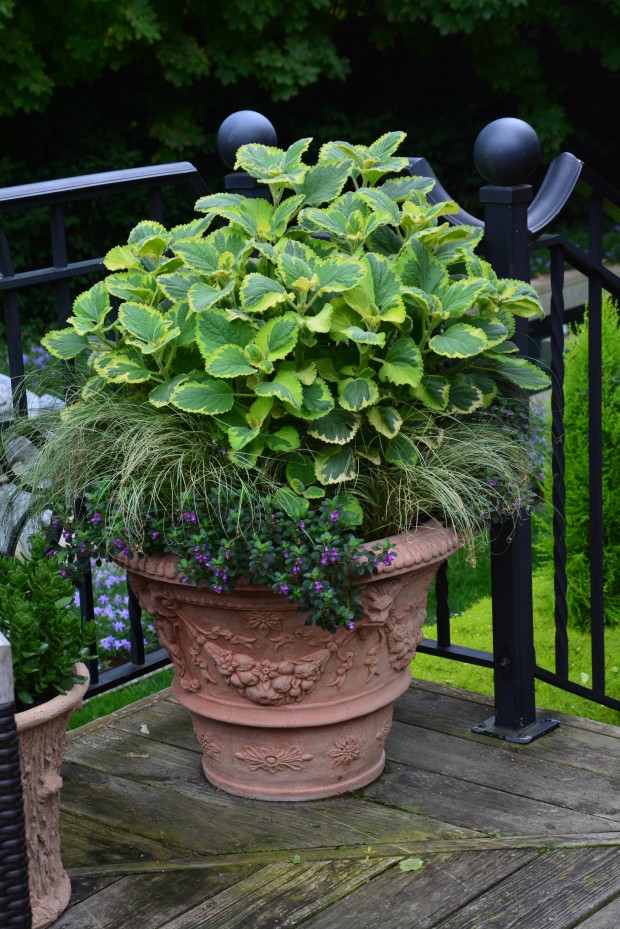 Though our summer has been mostly moderate and regularly rainy, we are in the throes of a hot spell. It is hot enough to make working in the garden a sweat fest. Oh yes, the hot days have gone on for a while. If I can’t be outside at 6am, I would rather wait until 6pm. Do the tropical/seasonal plants in my pots mind an 88 degree day? Not at all. Many of them originate in very hot climates. They have been waiting for this heat since late May. It is important to differentiate between what you would like on a hot day, and what your container plants would like. I do not water my containers when it is hot. I might like a cool shower after a hot day outdoors, but tropical plants thrive in the hot heat. I only water them when they are dry, or in imminent danger of becoming dry. I water dry plants, not hot plants.
Though our summer has been mostly moderate and regularly rainy, we are in the throes of a hot spell. It is hot enough to make working in the garden a sweat fest. Oh yes, the hot days have gone on for a while. If I can’t be outside at 6am, I would rather wait until 6pm. Do the tropical/seasonal plants in my pots mind an 88 degree day? Not at all. Many of them originate in very hot climates. They have been waiting for this heat since late May. It is important to differentiate between what you would like on a hot day, and what your container plants would like. I do not water my containers when it is hot. I might like a cool shower after a hot day outdoors, but tropical plants thrive in the hot heat. I only water them when they are dry, or in imminent danger of becoming dry. I water dry plants, not hot plants.
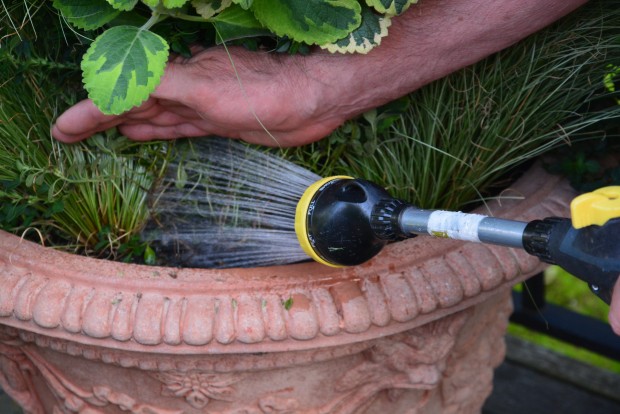 I have no scientific evidence to support the following-just my experience and instinct. On an 88 degree sunny day, I do not water my pots from the top. I would rather keep the foliage dry. Wet and heat put together is a reliably good recipe for disease. Mildew in a container – what gardener needs that? I use one hand to raise up the trailing plants on the edge, and the other to direct water to the surface of the dirt. No matter the size of the pot, I move the wand to different locations on the edge of the pot, so I am sure all the soil gets watered evenly. All around. Watering in one spot will invariably leave some other spot dry. I water the soil, all around, in hot weather.
I have no scientific evidence to support the following-just my experience and instinct. On an 88 degree sunny day, I do not water my pots from the top. I would rather keep the foliage dry. Wet and heat put together is a reliably good recipe for disease. Mildew in a container – what gardener needs that? I use one hand to raise up the trailing plants on the edge, and the other to direct water to the surface of the dirt. No matter the size of the pot, I move the wand to different locations on the edge of the pot, so I am sure all the soil gets watered evenly. All around. Watering in one spot will invariably leave some other spot dry. I water the soil, all around, in hot weather.
 When plants get large, it is not always so easy to see where the interior of the pot actually is. There’s no sense to watering outside the pot.
When plants get large, it is not always so easy to see where the interior of the pot actually is. There’s no sense to watering outside the pot.
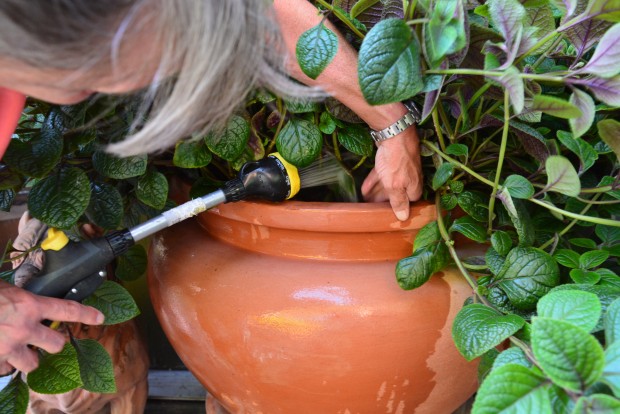 This chocolate soldier plectranthus has gotten so large that it takes my whole arm to to flip up the trailing portion, and direct water to the soil. As this pot is located in the corner of my deck, it isn’t feasible to go all the way around it with my wand. The best part for this plant – no water goes on the foliage. The water need to go to the roots.
This chocolate soldier plectranthus has gotten so large that it takes my whole arm to to flip up the trailing portion, and direct water to the soil. As this pot is located in the corner of my deck, it isn’t feasible to go all the way around it with my wand. The best part for this plant – no water goes on the foliage. The water need to go to the roots.
 Watering a seasonal container properly takes a little finesse. This container needs water at the center. A rim watering is not enough. My left hand has located the surface of the soil in the middle, while my right hand delivers the water. How do I know how this pot needs water? I touch the soil. If it is hard and crusty, (as soil tends to get towards the end of the growing season, when the plants are heavily rooted) I water until that soil softens, and feels spongy to the touch. This pot I may need to water twice, to get it sufficiently soaked. I will not water again until the soil has dried out.
Watering a seasonal container properly takes a little finesse. This container needs water at the center. A rim watering is not enough. My left hand has located the surface of the soil in the middle, while my right hand delivers the water. How do I know how this pot needs water? I touch the soil. If it is hard and crusty, (as soil tends to get towards the end of the growing season, when the plants are heavily rooted) I water until that soil softens, and feels spongy to the touch. This pot I may need to water twice, to get it sufficiently soaked. I will not water again until the soil has dried out.
 Flipping the leaves up in a container gives me a look at the soil below, and helps me to direct the water horizontally across the surface of the soil. Plants are more forgiving of their leaves being handled as a group. Handling a single leaf can result in breakage. Water directed to the roots of plants in need is life giving.
Flipping the leaves up in a container gives me a look at the soil below, and helps me to direct the water horizontally across the surface of the soil. Plants are more forgiving of their leaves being handled as a group. Handling a single leaf can result in breakage. Water directed to the roots of plants in need is life giving.
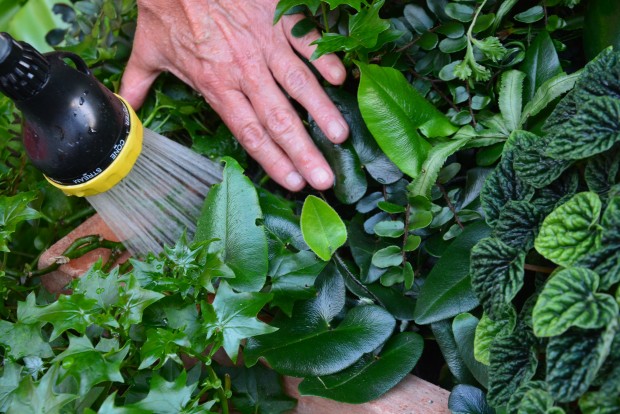 The German ivy at the lower left in this picture is trailing just about to the ground now. As the vines are very juicy, heavy, and brittle, I move the leaves just above the rootball as gently as possible, and water from the top. I wouldn’t want to risk breaking an entire branch. I would not flip up German ivy trailers in search of the soil surface. I shine that water down on its root ball, as best I can. Every plant in a container needs to be watered differently.
The German ivy at the lower left in this picture is trailing just about to the ground now. As the vines are very juicy, heavy, and brittle, I move the leaves just above the rootball as gently as possible, and water from the top. I wouldn’t want to risk breaking an entire branch. I would not flip up German ivy trailers in search of the soil surface. I shine that water down on its root ball, as best I can. Every plant in a container needs to be watered differently.
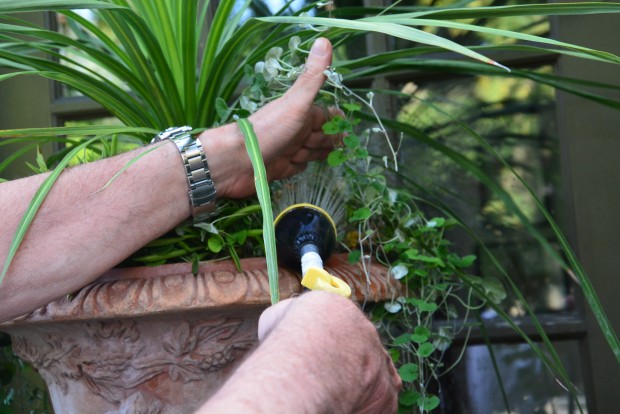 Dichondra, on the other hand, is a light weight and pliable vine. The round leaves do a decent job of repelling water, should I water from the top. The best way to get the water to the roots of a dichondra is to get the leaves out of the way. Once I have watered those roots, I set the vines back down. Gently.
Dichondra, on the other hand, is a light weight and pliable vine. The round leaves do a decent job of repelling water, should I water from the top. The best way to get the water to the roots of a dichondra is to get the leaves out of the way. Once I have watered those roots, I set the vines back down. Gently.
 This pot full of belamcanda lilies is thoroughly rooted. All of the growth is upright, so watering at the bottom is easy. On an 88 degree day, I flood the soil until the water comes up to the rim. After the water drains, I will refill the pot until I see evidence of water draining all of the way out the bottom.
This pot full of belamcanda lilies is thoroughly rooted. All of the growth is upright, so watering at the bottom is easy. On an 88 degree day, I flood the soil until the water comes up to the rim. After the water drains, I will refill the pot until I see evidence of water draining all of the way out the bottom.
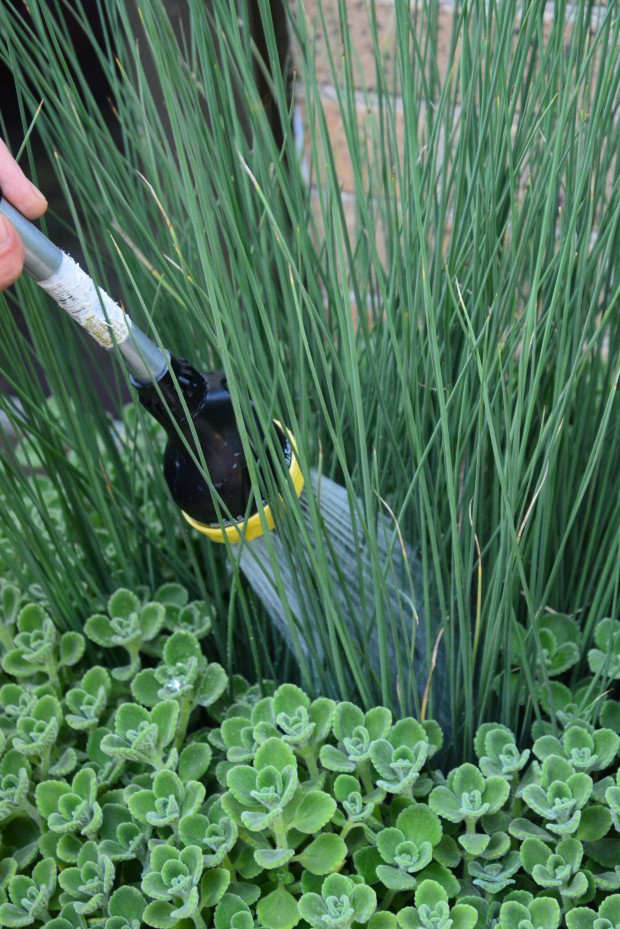 The rush in this pot is very fond of water. The Cuban oregano-it is happy to be dryer. Some pots need selective watering. I make the time to do this. I pour the water to the rush, and water the oregano every so often.
The rush in this pot is very fond of water. The Cuban oregano-it is happy to be dryer. Some pots need selective watering. I make the time to do this. I pour the water to the rush, and water the oregano every so often.
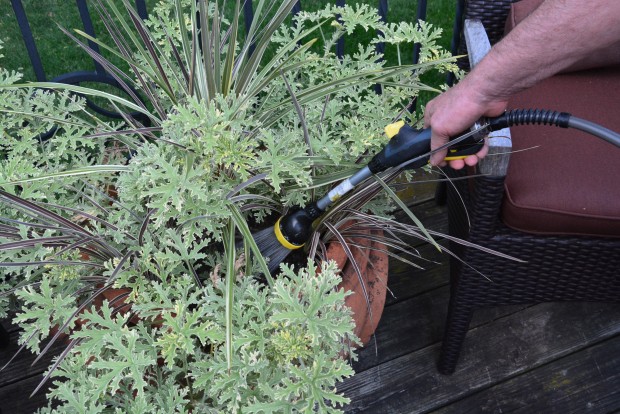 This pot planted with a rose scented geranium and a number of phormiums-I water it from the top. I cannot really explain why. The rose scented geranium does not bend much. The phormium is vulnerable to breakage at the crown. Why all this talk about watering? Container plantings need regular and thoughtful watering. People regularly ask me why my pots look good so late in the season, and during really hot weather. It’s the watering.
This pot planted with a rose scented geranium and a number of phormiums-I water it from the top. I cannot really explain why. The rose scented geranium does not bend much. The phormium is vulnerable to breakage at the crown. Why all this talk about watering? Container plantings need regular and thoughtful watering. People regularly ask me why my pots look good so late in the season, and during really hot weather. It’s the watering.

